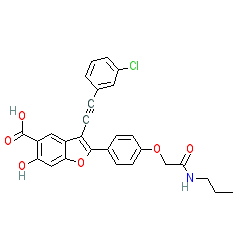|
Compound class:
Synthetic organic
Comment: Compound 8a was designed as a small-molecule inhibitor of the lymphoid-specific non-receptor tyrosine phosphatase, LYP (PTPN22) [1]. PTPN22 directly dephosphorylates several kinase enzymes, effecting negative regulation of T-cell receptor (TCR) signaling [3], and is implicated in autoimmune diseases [4].
Ligand Activity Visualisation ChartsThese are box plot that provide a unique visualisation, summarising all the activity data for a ligand taken from ChEMBL and GtoPdb across multiple targets and species. Click on a plot to see the median, interquartile range, low and high data points. A value of zero indicates that no data are available. A separate chart is created for each target, and where possible the algorithm tries to merge ChEMBL and GtoPdb targets by matching them on name and UniProt accession, for each available species. However, please note that inconsistency in naming of targets may lead to data for the same target being reported across multiple charts. ✖ |
|
|||||||||||||||||||||||||||||||||||
| Immunopharmacology Comments |
| PTPN22 inhibitors are being used to study the role of this enzyme in immune system function and regulation, particularly since a gain-of-function mutation in the enzyme (R628W; exhibits elevated phosphatase activity and more effective T cell signalling inhibition capacity than the wild-type enzyme [2]) correlates with susceptibility to several human autoimmune diseases. |








